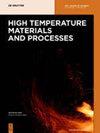Effect of cold-rolling deformation and rare earth yttrium on microstructure and texture of oriented silicon steel
IF 1.5
4区 材料科学
Q4 MATERIALS SCIENCE, MULTIDISCIPLINARY
引用次数: 0
Abstract
Abstract In order to study the effect of cold-rolling deformation and rare earth Y on the microstructure and texture of 3.0% Si-oriented silicon steel, the microstructure and texture of cold-rolled oriented silicon steel with 60, 72, and 86% deformation are analyzed using electron backscatter diffraction and image analysis software. The experimental results show that the deformation band becomes narrower and the distribution of shear bands becomes denser with increasing cold-rolling deformation. Compared to the Y-free steel, cold-rolled sheet containing rare earth Y has greater shear bands. The pinning effect of rare earth Y hinders the dislocation movement, which leads to the increase of kernel average misorientation value and shear bands. With the increase of cold-rolling deformation, the texture concentrates on α and λ. This is mainly due to the change from {100} 〈001〉 to {001} 〈110〉, intensifying λ texture, and the change from {111} 〈112〉 to {111} 〈110〉, thus strengthening the α texture. The texture strength of cold-rolled sheets can be decreased by rare earth Y. But the γ texture strength in cold-rolled sheets containing Y is significantly higher than in those without Y. The γ texture strength can reach up to 7.3, and the strong points are mainly {111} 〈112〉. This is because the number of inclusions in steel increases with the addition of rare earth Y. In the process of grain nucleation, the {111} oriented grains nucleate heterogeneously on the inclusions. It forms a large number of {111} oriented grains and improves the γ texture strength.冷轧变形和稀土钇对取向硅钢组织和织构的影响
摘要为了研究冷轧变形和稀土Y对3.0%Si取向硅钢组织和织构的影响,利用电子背散射衍射和图像分析软件对60、72和86%变形的冷轧取向硅钢的组织和织构进行了分析。实验结果表明,随着冷轧变形量的增加,变形带变窄,剪切带分布致密。与无Y钢相比,含有稀土Y的冷轧板具有更大的剪切带。稀土Y的钉扎效应阻碍了位错的运动,导致核平均取向差值和剪切带的增加。随着冷轧变形量的增加,织构集中在α和λ上。这主要是由于从{100}〈001〉到{001}〈110〉的变化,强化了λ织构,从{111}〈112〉到{111}〉〈110〉,从而强化了α织构。稀土Y可以降低冷轧板的织构强度,但含有Y的冷轧板的γ织构强度明显高于不含Y的冷轧片。γ织构强度可达7.3,其强点主要为{111}〈112〉。这是因为钢中夹杂物的数量随着稀土Y的加入而增加。在晶粒成核过程中,{111}取向的晶粒在夹杂物上非均匀成核。它形成了大量的{111}取向晶粒,提高了γ织构强度。
本文章由计算机程序翻译,如有差异,请以英文原文为准。
求助全文
约1分钟内获得全文
求助全文
来源期刊

High Temperature Materials and Processes
工程技术-材料科学:综合
CiteScore
2.50
自引率
0.00%
发文量
42
审稿时长
3.9 months
期刊介绍:
High Temperature Materials and Processes offers an international publication forum for new ideas, insights and results related to high-temperature materials and processes in science and technology. The journal publishes original research papers and short communications addressing topics at the forefront of high-temperature materials research including processing of various materials at high temperatures. Occasionally, reviews of a specific topic are included. The journal also publishes special issues featuring ongoing research programs as well as symposia of high-temperature materials and processes, and other related research activities.
Emphasis is placed on the multi-disciplinary nature of high-temperature materials and processes for various materials in a variety of states. Such a nature of the journal will help readers who wish to become acquainted with related subjects by obtaining information of various aspects of high-temperature materials research. The increasing spread of information on these subjects will also help to shed light on relevant topics of high-temperature materials and processes outside of readers’ own core specialties.
 求助内容:
求助内容: 应助结果提醒方式:
应助结果提醒方式:


